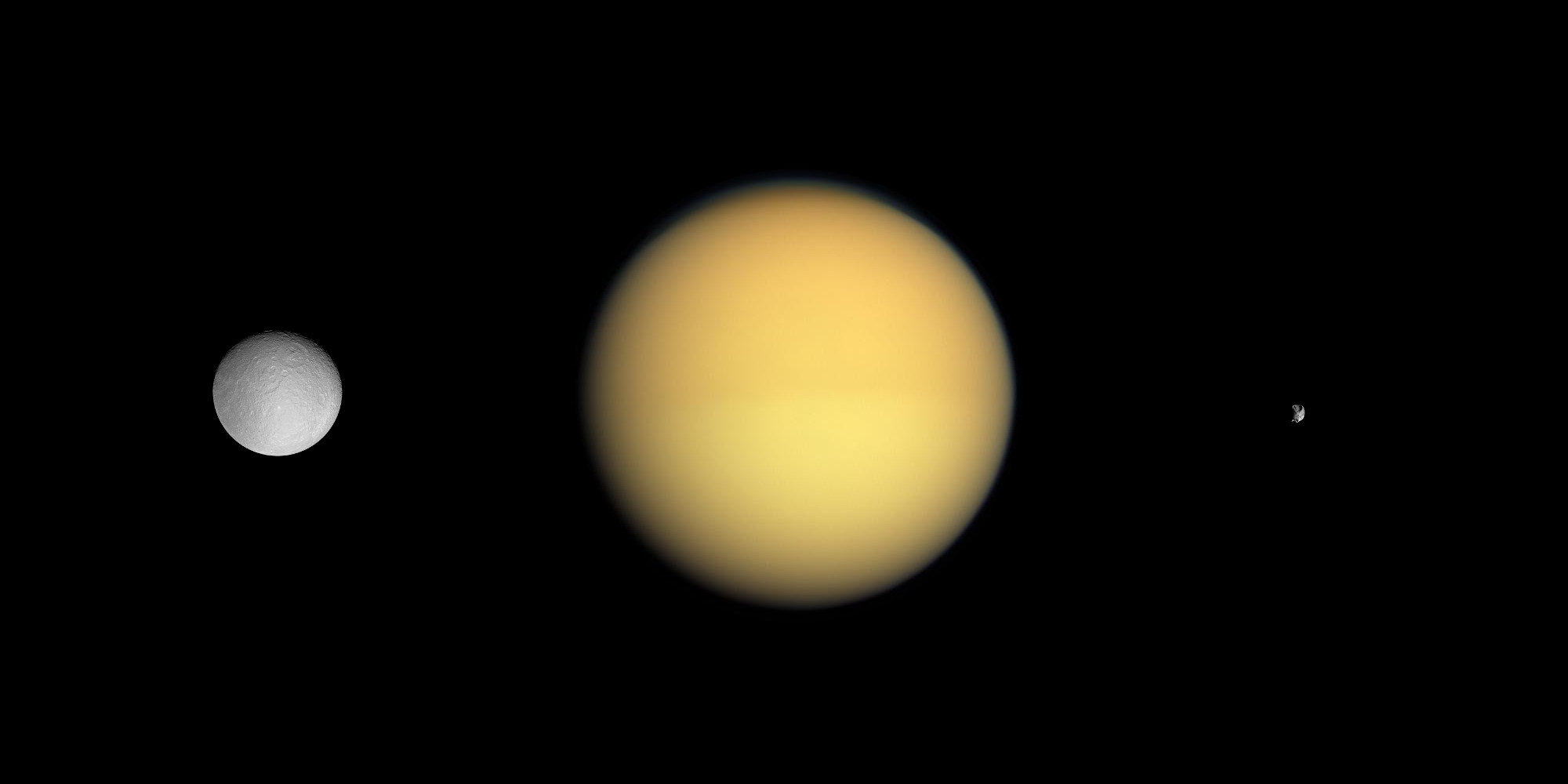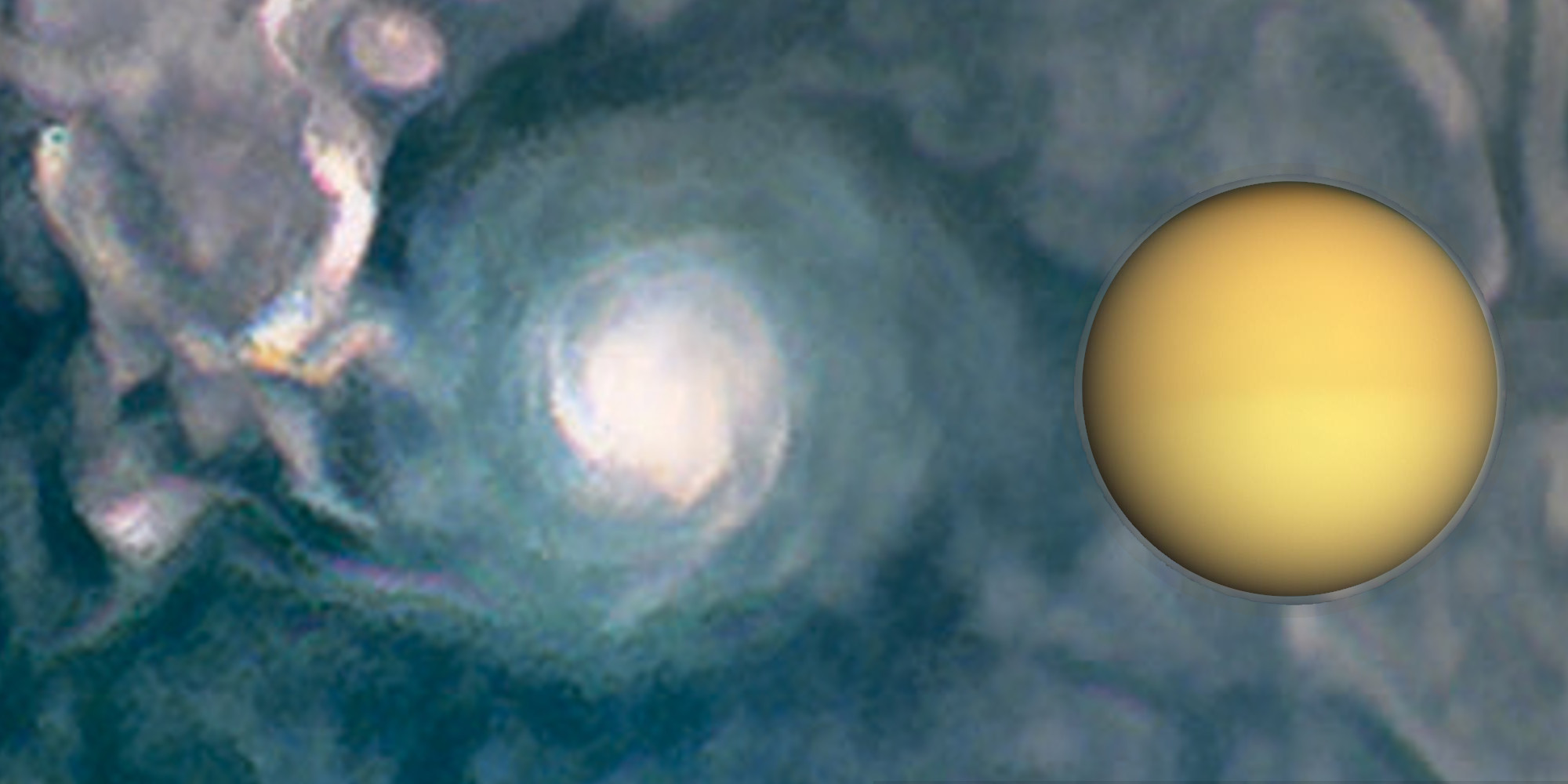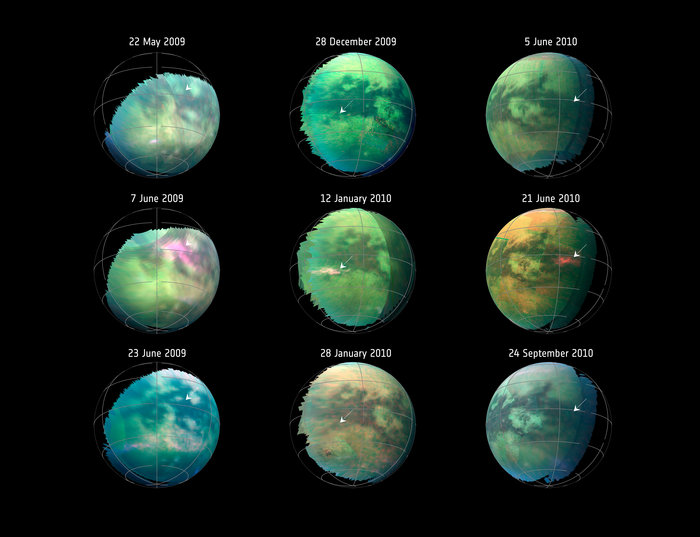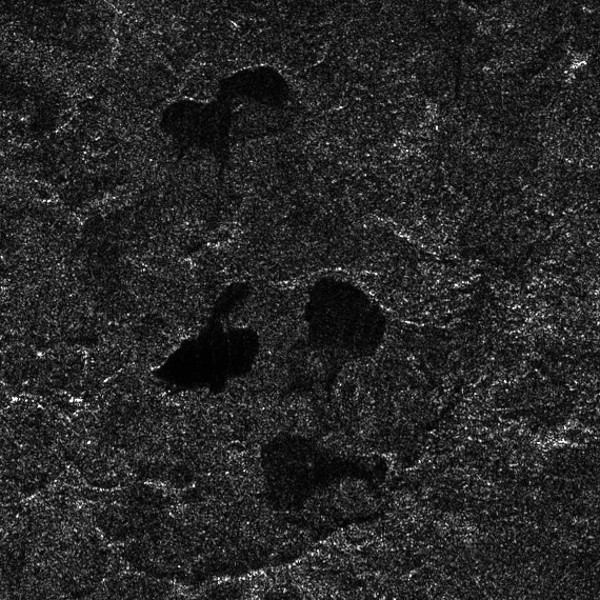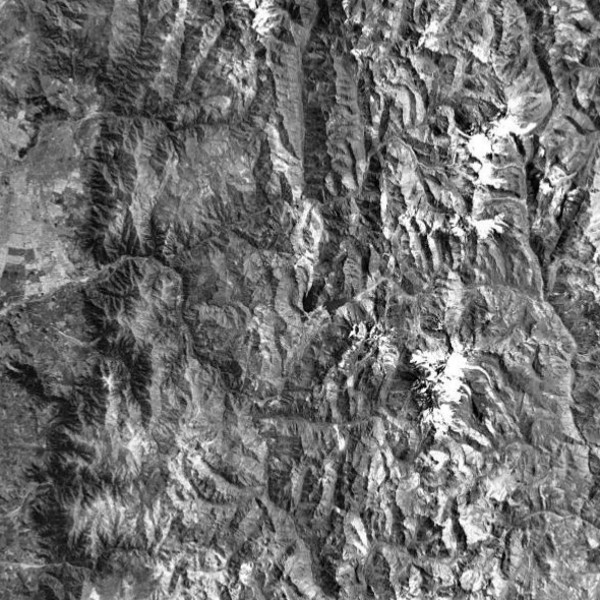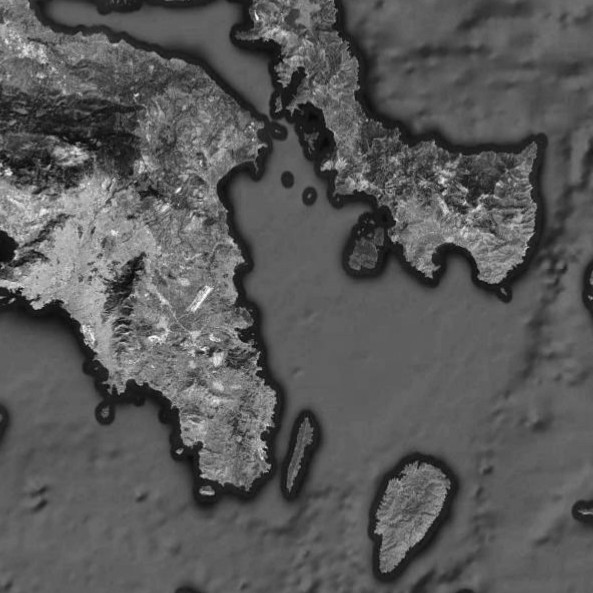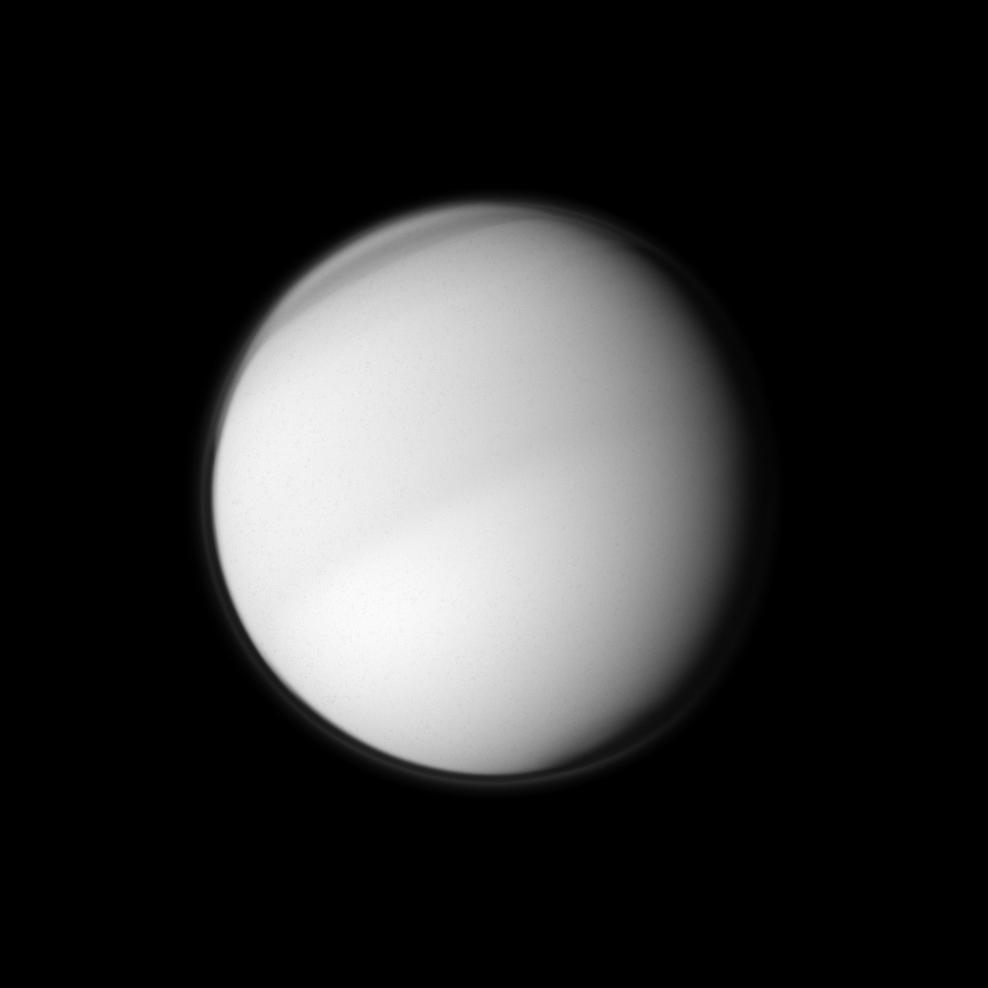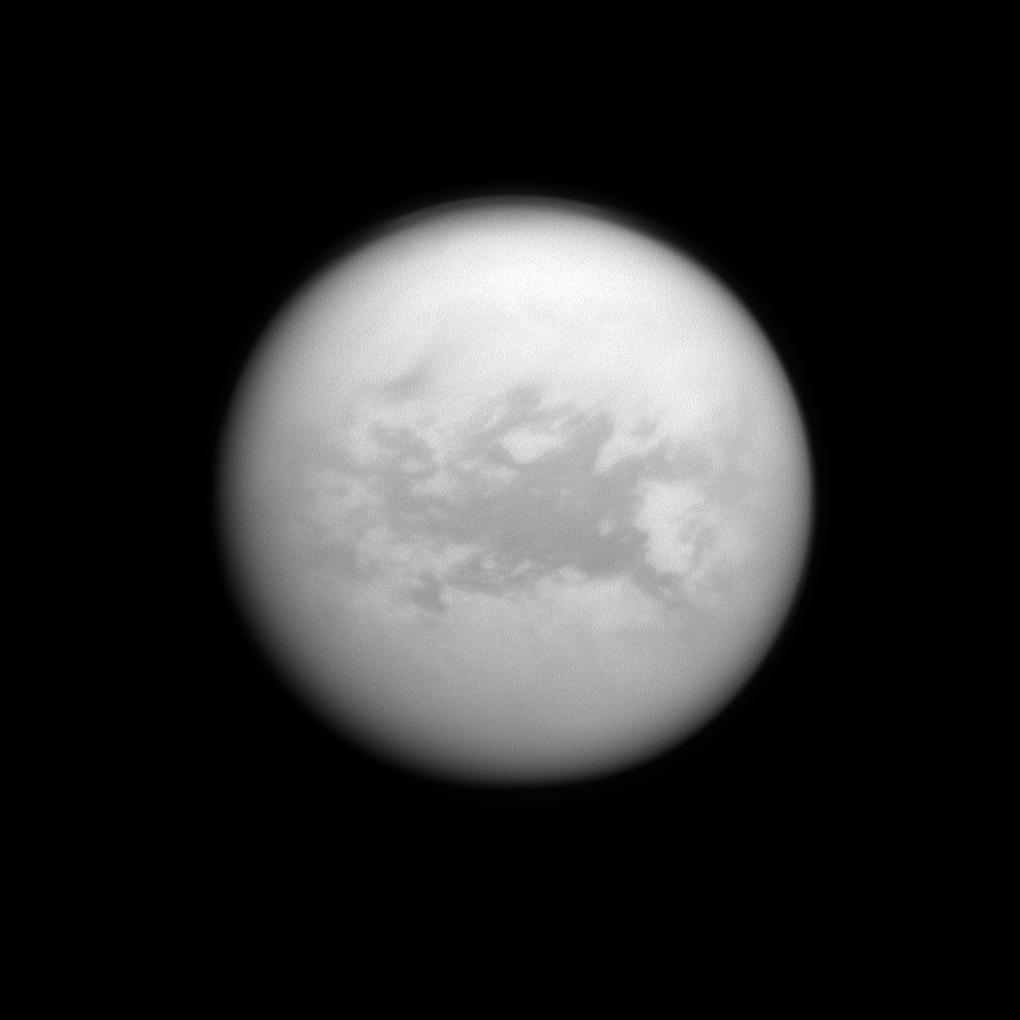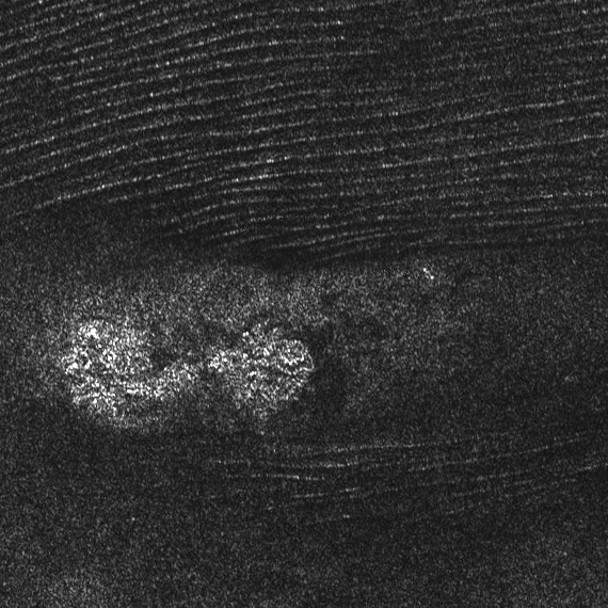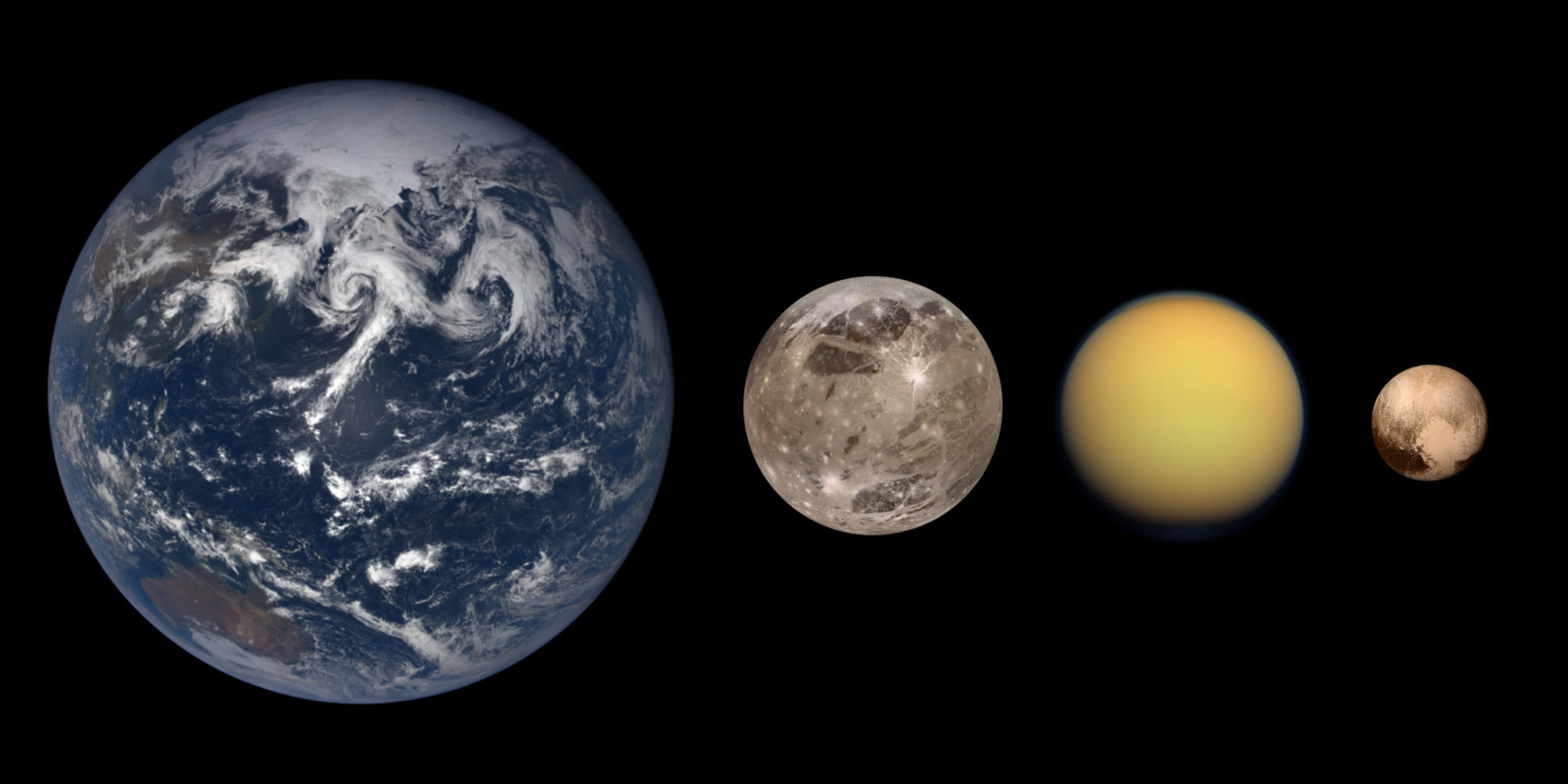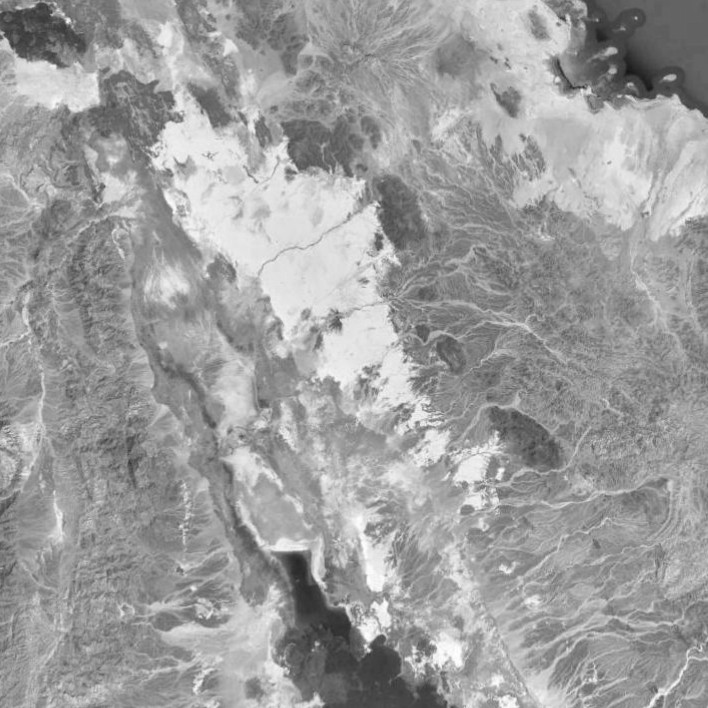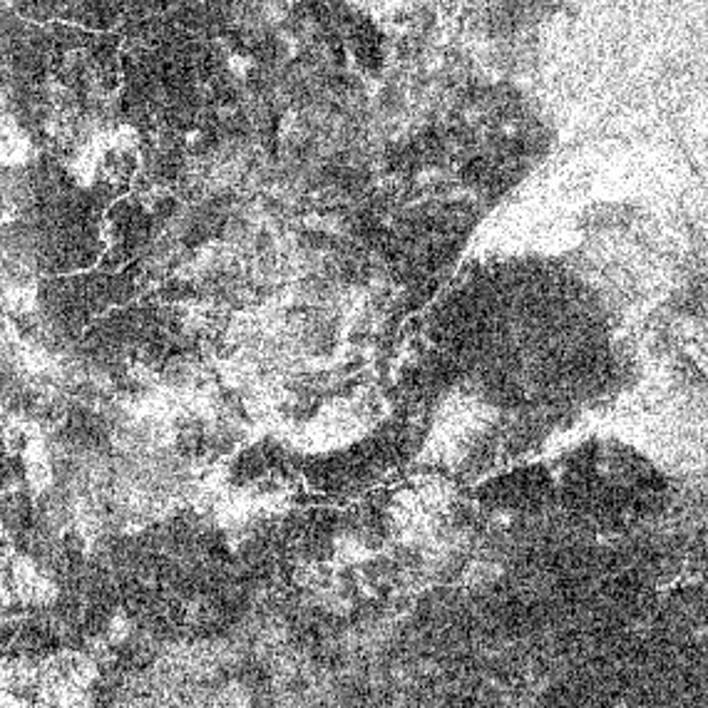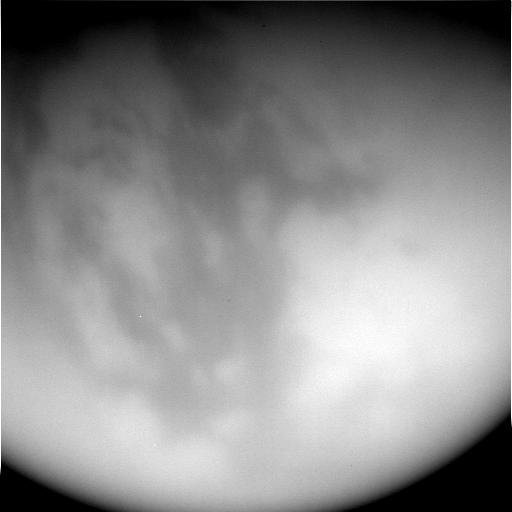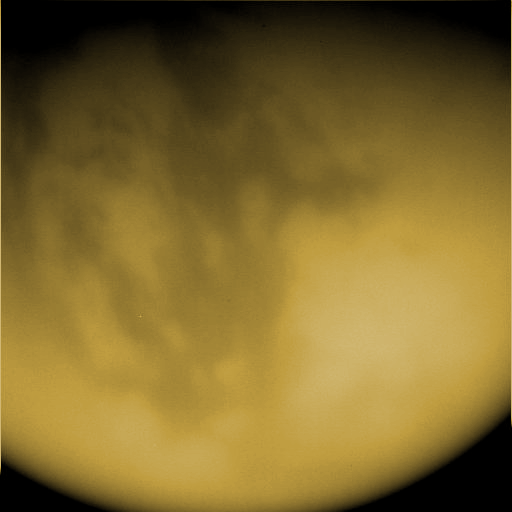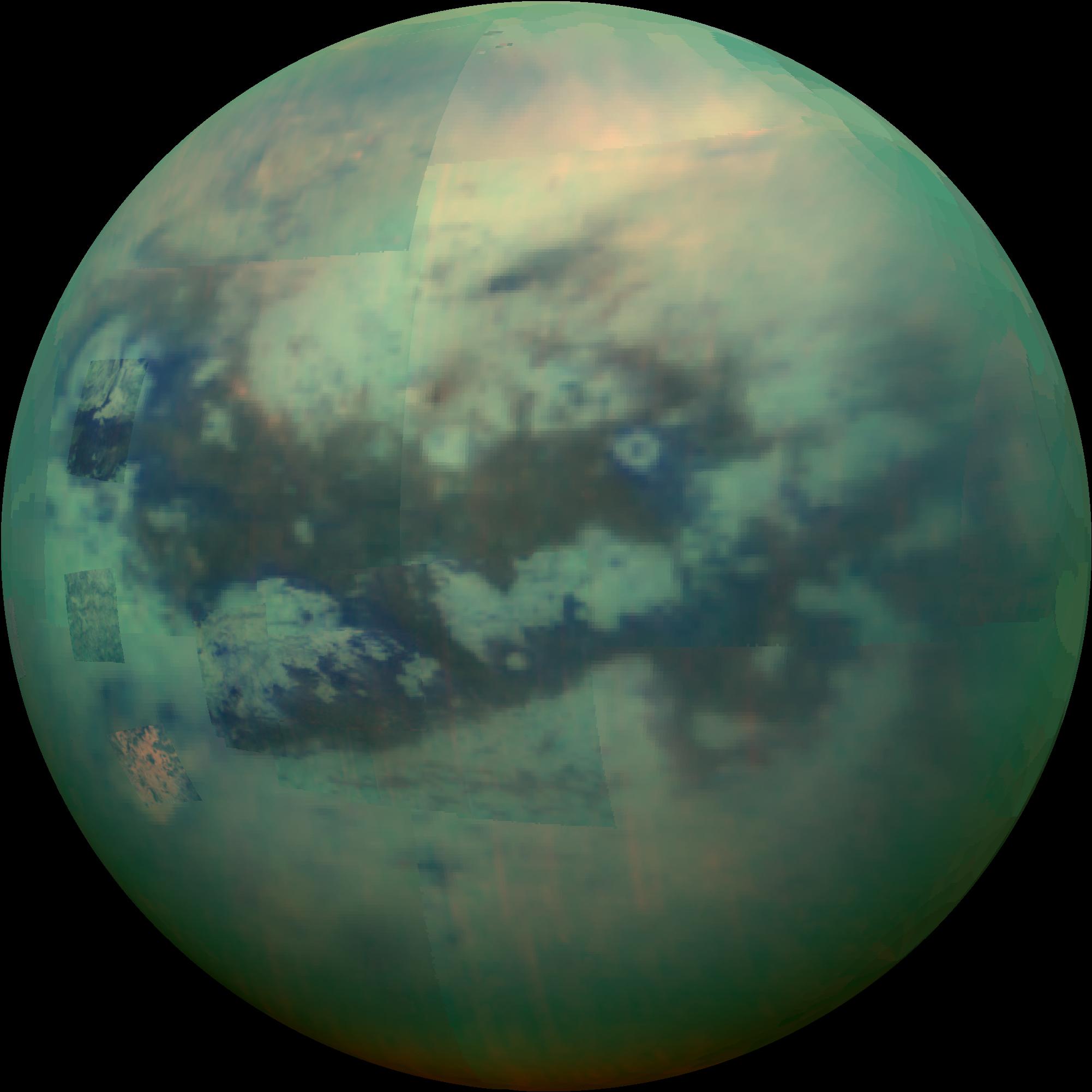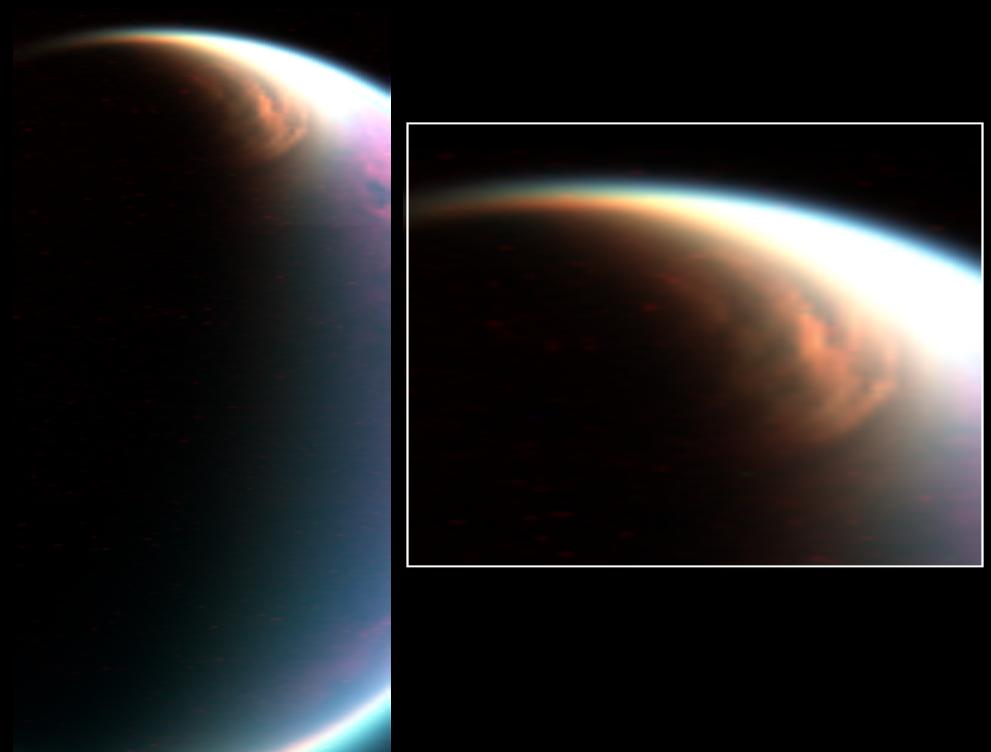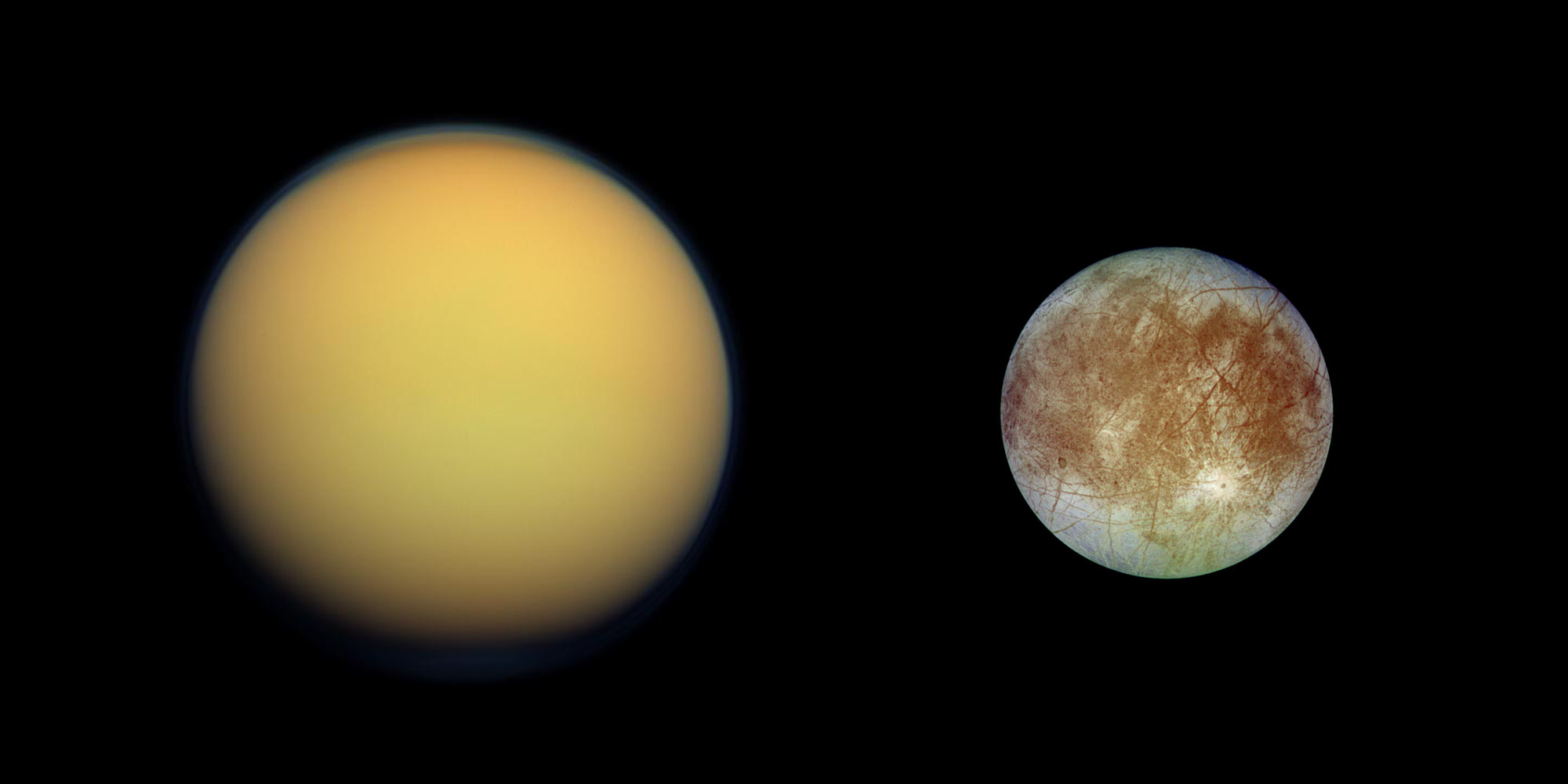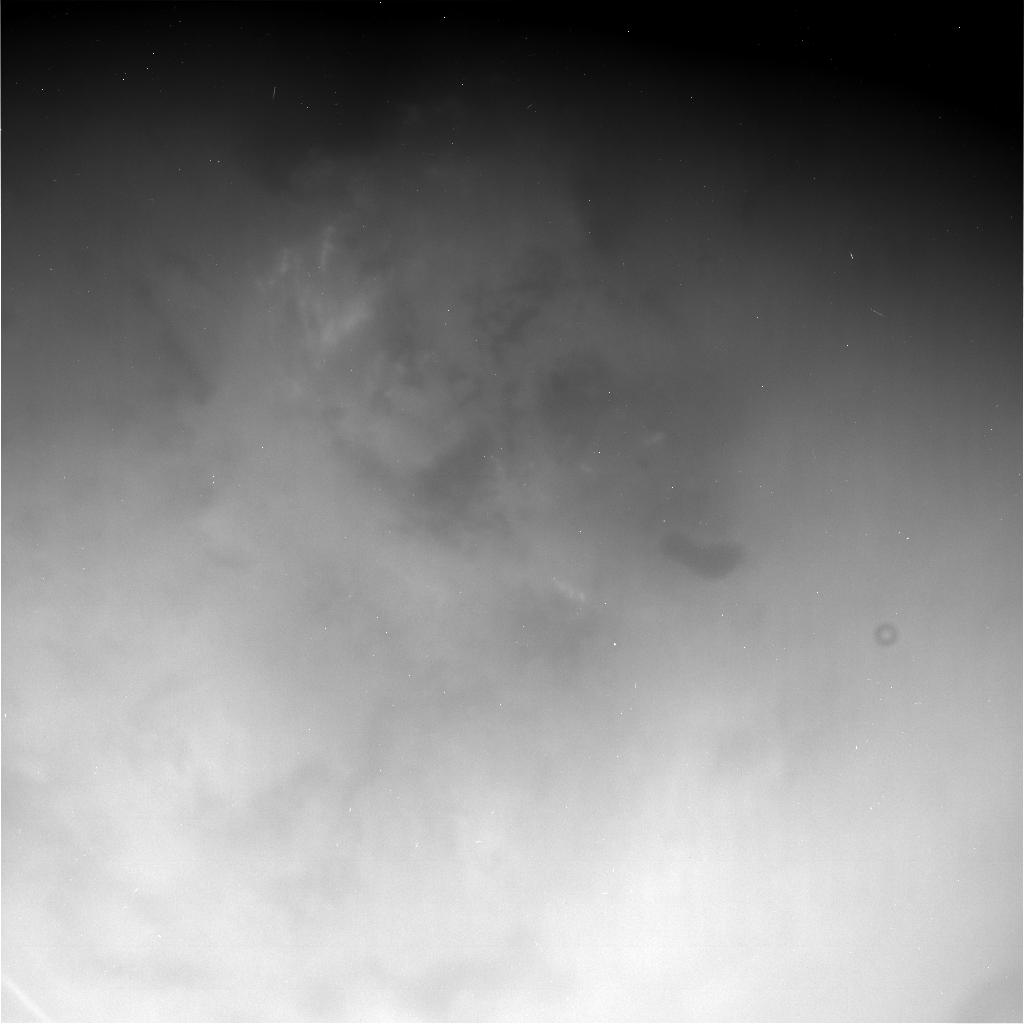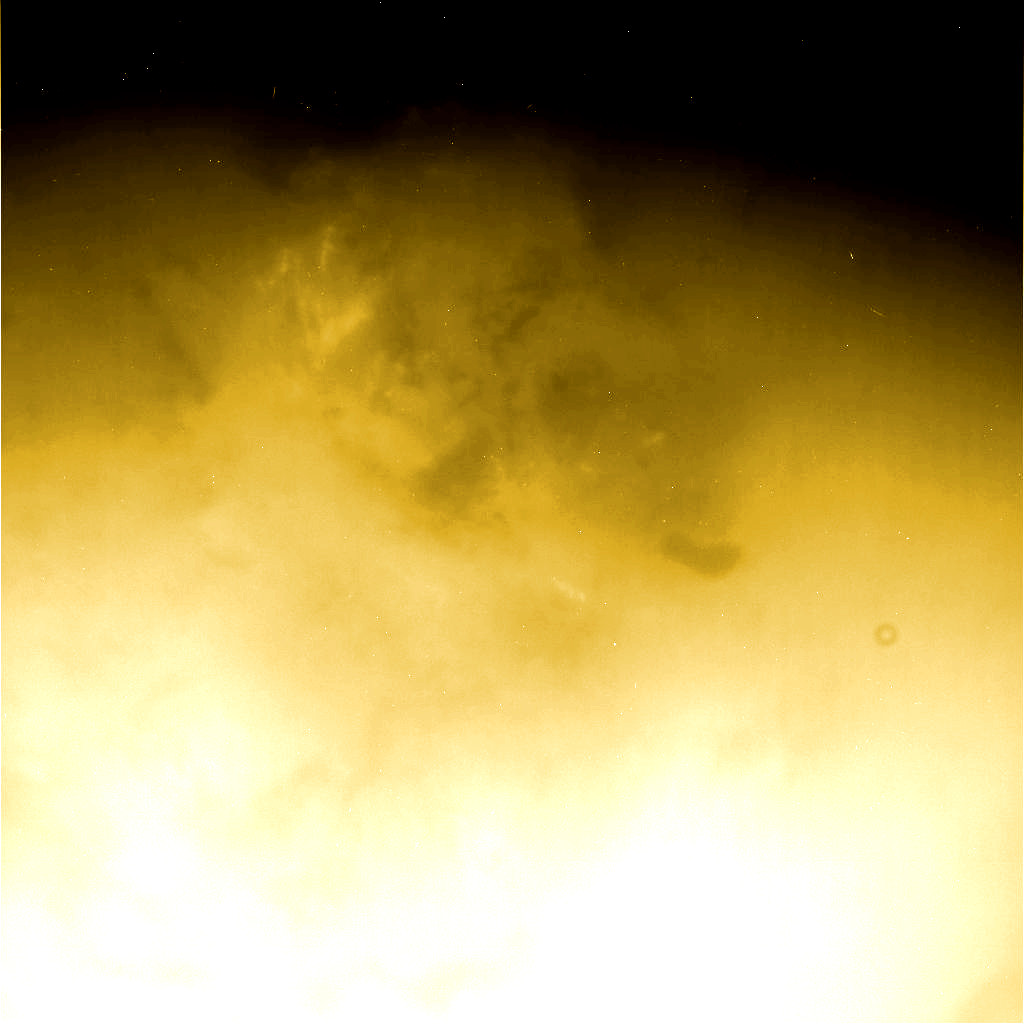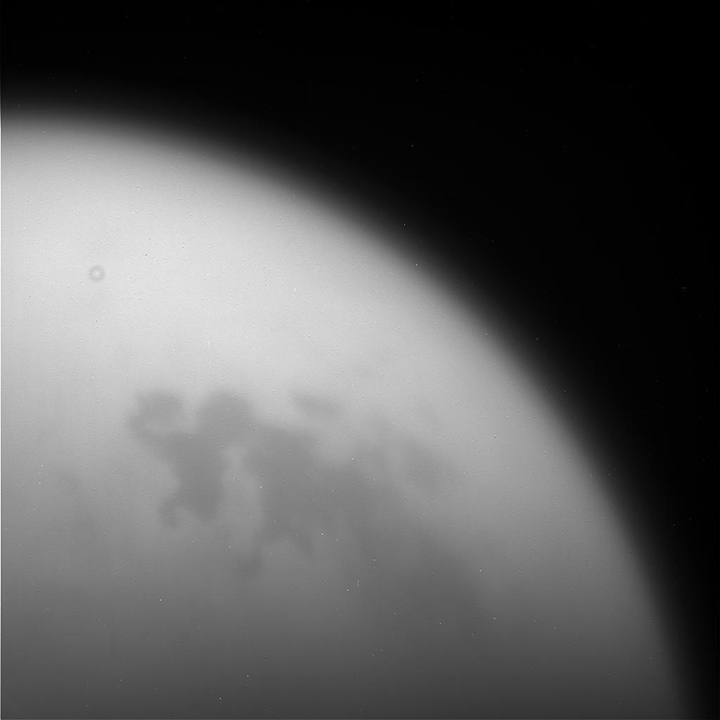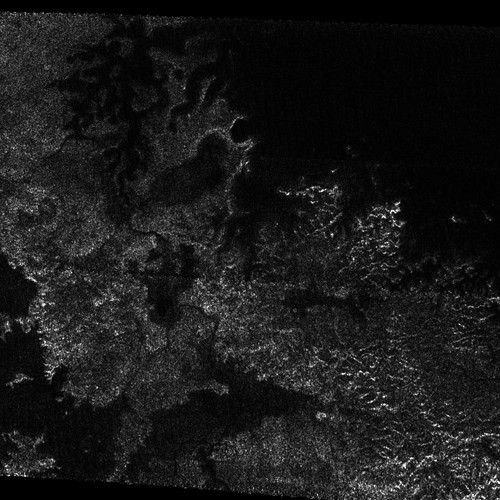Titan News 2018
December 6, 2018 : A New Study Reveals That Saturn's Rings, Titan And The Other Moons Of The Gas Giant May Surprisingly Contain The Same Type Of Water As The Earth Except For Phoebe Which Contains A Heavier Water
A new study entitled « Isotopic Ratios of Saturn's Rings and Satellites: Implications for the Origin of Water and Phoebe », recently published in the journal Icarus and proposed by a group of researchers involving Planetary Science Institute Senior Scientist Roger N. Clark as well as the collaborators Robert H. Brown (University of Arizona), Dale P. Cruikshank (NASA) and Gregg A. Swayze from the USGS, shows that Saturn's rings, Titan and the other moons of the second largest planet in the Solar System, except for Phoebe, surprisingly contain the same type of water as the Earth. The outcome is unexpected and surprising because Phoebe is composed of a heavier water than the other objects evolving around Saturn and because the other moons of the Gas Giant, from Mimas to Rhea or Titan, contain the same type of water molecule as our own planet. The conclusion was made possible thanks to the development of a new method for detemining isotopic ratios of water and carbon dioxide from the spacecraft or the orbiter.
Isotopes correspond to different forms of the same element. Each element has a precise number of protons but it can contain a different number of neutrons. Therefore, the same element can be a different type of the same element that is to say a different isotope. If the element incorporates more neutrons, it will be heavier and it will be likely to have an impact on the formation mechanisms of any planet, comet or moon. The planetologists have focused their attention on the isotopes of water, a well-known molecule with the chemical formula H2O and composed of two hydrogen atoms and one oxygen atom. If a neutron is incorporated into the hydrogen atom of the water molecule, the hydrogen atom becomes Deuterium (D) and the water molecule will be heavier with a mass increased by approximately 5 percent. The water molecule with a heavier hydrogen atom represents a heavy water known as HDO.
|
The image above corresponds to a mosaic of views of Rhea, Titan and Phoebe obtained from the Cassini orbiter during its mission in the Saturn System. Those three moons of the Gas Giant Saturn are represented at scale, here. The original images of the mosaic of Rhea were taken with the Narrow-Angle Camera of the Cassini spacecraft on November 26, 2005. The original view of Saturn's largest moon Titan was generated on the basis of data collected on August 25, 2009 with the Wide-Angle Camera of the Cassini orbiter. The original images of the mosaic of Phoebe were acquired on June 11, 2004 from the Cassini probe. Rhea, Titan and Phoebe may be rich in water. The water of Rhea and Titan where a subsurface ocean of liquid water may exist appears to be the same type of water as on Earth. That's not the case for Phoebe where the type of water appears heavier than on the other moons of Saturn. Credit for the
original view of Rhea: NASA/JPL/Space
Science Institute. |
October 9, 2018 : A New Study Reveals A Simulation Showing That Polycyclic Aromatic Hydrocarbons Can Form In The Low-Temperature Environment Of Titan And Can Engender The Brown-Orange Haze We Observe Today
A new study entitled « Low-temperature formation of polycyclic aromatic hydrocarbons in Titan's atmosphere », published on October 8, 2018 in the journal Nature Astronomy and proposed by a team of researchers involving Ralf Kaiser and Musahid Ahmed, reveals that polycyclic aromatic hydrocarbons can form from benzene in a low-temperature environment similar to the environment of Titan's atmosphere where a brown-orange haze is observed today. The surprising outcome based on laboratory experiments and computer simulations demonstrates that the complex haze of Saturn's largest moon Titan can result from various chemical reactions involving benzene (C6H6) and polycyclic aromatic hydrocarbons in a particularly harsh environment. The atmosphere of the Opaque Moon has always fascinated researchers because that gas blanket which is deep and thick is mostly composed of nitrogen like our atmosphere and because Titan's atmosphere is rich in methane. The surface of the giant moon can't be seen from outer space in the visible spectrum due to the presence of a haze or smog which is rich in hydrocarbons or organics.
Titan's atmosphere may represent a prebiotic natural laboratory since it is rich in organics and hydrocarbons that can engender particularly complex molecules. The new research work representing a collaboration of scientists in the Chemical Sciences Division at the Department of Energy's Lawrence Berkeley National Laboratory (Berkeley Lab), of the University of Hawaii at Manoa, of the Samara University in Russia and of the Florida International University, clearly demonstrates that a complex chemistry can take shape from benzene in a particularly harsh environment. Now, planetologists realize that chemical reactions involving benzene, at a low temperature, can produce multiple-ringed molecules which can lead to an even more complex chemistry. The complex chemistry of Titan's haze may be the outcome of that kind of chemical reactions involving benzene or other hydrocarbons. The analysis leads to the conclusion that theories which advance that high-temperature reactions are needed to produce the type of haze we observe on Saturn's largest moon today may not be accurate or may be wrong.
The natural color image above shows a portion of Titan's complex atmosphere. One can notice in particular the contrast in terms of colors between the lower part of the atmosphere which appears orange and the upper part of the atmosphere, composed of several layers, which appears blue. The surface of the enigmatic moon can't be seen in the visible spectrum from outer space due to the presence of a complex haze of organics and hydrocarbons. A remarkably complex chemistry is taking shape in Titan's atmosphere in a harsh environment, under the influence of ultraviolet light from the Sun. The image was generated on the basis of data acquired from the Cassini spacecraft on March 31, 2005. The images combined to produce the final view were obtained with green, red and blue spectral filters. Image credit: NASA/JPL/Space Science Institute.
October 1st, 2018 : Researchers Study The Atmosphere Of Jupiter And The Atmosphere Of Titan In Order To Better Evaluate The Impact Of Methane On Global Warming
A new study entitled « Large regional shortwave forcing by anthropogenic methane informed by Jovian observations », published in the journal Science Advances on September 26, 2018 and proposed by a team involving Daniel R. Feldman reveals that the study of Jupiter's atmosphere and of Titan's atmosphere allows us to better evaluate the impact of methane on our climate and the influence of methane on global warming on Earth. The atmosphere of Jupiter is dominated by hydrogen and helium but it also contains a relatively significant fraction of methane. The atmosphere of Saturn's largest moon Titan is dominated by nitrogen and the second most abundant gas in that gas blanket is methane. Therefore, researchers are in a position to study the potential influence of methane on environmental temperatures on Titan's surface or in the upper atmosphere of Jupiter. They can evaluate in a more precise way the influence of the increase in the level of methane in our atmosphere on the well-known phenomenon of global warming here on Earth.
The phenomenon of global warming appears to be closely related to greenhouse gases such as carbon dioxide or methane. Several types of gas can produce global warming or can increase the environmental temperature. Carbon dioxide, methane and water in the form of gas can trap the heat or the radiations from the Sun and engender a rise in the environmental temperature at sea level. Industrial or developed countries like China, France, Great Britain or Germany engender a lot of carbon dioxide via the burning of fossil fuels. And the level of carbon dioxide released into the atmosphere or into our environment tends to increase over time. The global economy is inexorably growing implying significant increases in the release of greenhouse gases such as carbon dioxide and methane. We often focus our attention on the role of carbon dioxide or CO2 regarding the impact of greenhouse gases on global warming but we tend to forget that methane or CH4 is a much more potent greenhouse gas than carbon dioxide. According to the Intergovernmental Panel on Climate Change (IPCC), the molecule of methane is more than 25 times more powerful than carbon dioxide in terms of warming effects in our environment and on our planet over the span of a century.
The image above reveals a portion of Jupiter in its south polar region as well as Saturn's largest moon Titan at scale. One can notice in particular a giant vortex which looks like a typical galaxy, which appears bigger than Titan and which is about the same size as the Red Planet Mars. The original view of Titan was obtained on August 25, 2009 from the Wide-Angle Camera of the Cassini orbiter. The original view of Jupiter displayed online on August 7, 2017 was generated on the basis of data obtained from the Juno probe. Credit for the original view of Titan: NASA/JPL/Space Science Institute. Credit for the original view of Jupiter: NASA/JPL-Caltech/SwRI/MSSS/Betsy Asher Hall/Gervasio Robles. Montage credit: Marc Lafferre, 2018.
September 25, 2018 : Dust Storms At Low Or Mid-Latitudes On Titan Identified In The Infrared Spectrum Thanks To Cassini Data
A new research work unveiled recently in Nature Geoscience, entitled « Observational evidence for active dust storms on Titan at equinox » and led by Sébastien Rodriguez who is an astronomer at the University Paris Diderot in France, reveals that dust storms can take shape from time to time at low latitudes on Saturn's largest moon Titan. Researchers have been in a position to identify dust storms on the basis of infrared data obtained from the Cassini orbiter with the Visual and Infrared Mapping Spectrometer. Titan appears to be the third world known where dust storms can form. We know that dust storms can take shape and develop on Earth and on the Red Planet Mars. Impressive dust storms have been observed in Australia for instance and recently a global dust storm has taken shape on Mars causing some trouble for the Opportunity Rover. The observations of dust storms on the Opaque Moon are likely to help us better understand the climate, the meteorology and the dynamics of Titan's complex environment.
Radar data obtained with the Radar Mapper of the Cassini spacecraft during its long mission in the Saturn System ranging from mid-2004 to the second half of 2017 had revealed the presence of « Cat Scratches », Seif dunes or linear and parallel dunes extending over long distances in the dark areas of the low or mid-latitudes on Titan. Therefore, we knew that prevailing winds can shape the landscape and engender linear and parallel dunes over long distances on the Orange Moon. Now, we realize the potential power of winds at low or mid-latitudes on that enigmatic world. There can be large-scale dust storms at low or mid-latitudes on Titan which implies that the landscape of dunes can be remarkably dynamic. Let's note that the air is particularly dense on the surface of the giant moon. The atmospheric pressure on Titan's surface is higher than that of our planet at sea level. Sébastien Rodriguez pointed out : « Titan is a very active moon. » He added : « We already know that about its geology and exotic hydrocarbon cycle. Now we can add another analogy with Earth and Mars: the active dust cycle. »
The mosaic of images of Titan's disk above, obtained with the Visual and Infrared Mapping Spectrometer of the Cassini orbiter from May 22, 2009 to September 24, 2010, shows the evolution of surface and atmospheric features on the giant moon. One can observe in particular transient bright features at a relatively low latitude over low-albedo areas in the view of January 12, 2010 and in the view of June 21, 2010. The bright features appearing over areas which are rich in dune fields may correspond to dust storms rather than methane storms according to Sébastien Rodriguez and his team. Image credit: NASA/JPL-Caltech/University of Arizona/University Paris Diderot /IPGP/S. Rodriguez et al. 2018.
September 14, 2018: Planetologists Have Been Surprised By The Remarkable Asymmetry In The Distribution Of Surface Liquids Between The North Polar Region And The South Polar Region On Titan During The Cassini Mission
During its journey inside the Saturn System between 2004 and 2017, the Cassini spacecraft has obtained a huge amount of data regarding Saturn and its numerous moons, from Mimas to Enceladus, Titan or Iapetus. The Cassini orbiter was equipped with multiple instruments to observe or study the Gas Giant Saturn and its natural satellites. For instance, the Visual and Infrared Mapping Spectrometer of the probe was able to acquire infrared or near-infrared data regarding Saturn or Titan and it appeared clearly adapted for the observation of Saturn's largest moon in particular. Titan appears completely opaque from outer space in the visible spectrum. The surface of Titan as well as cloud formations become visible with a camera using spectral filters sensitive to infrared or near-infrared light. Thanks to the Visual and Infrared Mapping Spectrometer, we were in a position to observe and study the surface of the Opaque Moon as well as meteorological phenomena. The Cassini spacecraft was also equipped with a radar instrument which allowed us to observe the surface as well and which turned out to be particularly fruitful.
One of the main discoveries during
the Cassini-Huygens mission is clearly the identification of lakes and seas of
hydrocarbons in the high latitudes of Titan, undoubtedly one of the most
fascinating worlds in the Solar System. Researchers had anticipated that we
would find lakes, seas or even oceans of methane or ethane on Titan but the
panoramic images acquired during the atmospheric descent of the Huygens probe
on January 14, 2005 clearly showed that the brown or dark plain where the
Huygens probe was going to land was devoid of any liquid during that Summer
period in the southern hemisphere of Titan. Later, we found, on the basis of
infrared data from the Cassini orbiter, Ontario Lacus, the first body of
surface liquids identified on the giant moon. Ontario Lacus, likely composed
of methane and ethane, appeared at a high latitude in the southern hemisphere.
The radar data obtained from the Cassini spacecraft revealed that the dark or
low-albedo areas found at low or mid-latitudes and marking a sharp contrast
with relatively bright areas were dominated by Seif dunes or linear and
parallel dunes extending over long distances.

The image above corresponds to a mosaic of near-infrared images of Titan obtained from the ISS Narrow-Angle Camera of the Cassini probe on September 11, 2017. One can notice in particular Kraken Mare, Ligeia Mare and Punga Mare which may be filled with a mixture of methane and ethane incorporating dissolved nitrogen. All those pools of liquids are found in the high latitudes of the northern hemisphere of that intriguing moon. Image credit: NASA/JPL-Caltech/SSI.
July 21, 2018 : A New Study Suggests That We Should Look For Life In Large Impact Craters On Titan
A new study entitled « Strategies for Detecting Biological Molecules on Titan », appearing in the journal Astrobiology in May 2018 and proposed by a team led by Doctor Catherine Neish, a planetary scientist who is an expert in impact cratering at the University of Western Ontario, reveals that large impact craters on Saturn's largest moon Titan may be the best places to look for life, biological molecules or prebiotic chemistry. Many researchers believe that Titan may host the building blocks of life and its impact craters deserve our whole attention. The giant moon of Saturn may have all the ingredients for the development of complex organics. Its deep and thick atmosphere is dominated by nitrogen like our atmosphere and is composed of a significant concentration of methane. There is a haze rich in organics and hydrocarbons in Titan's atmosphere. That haze or smog prevents us from discerning surface features from outer space in the visible spectrum. Some lakes, seas and rivers of methane and ethane have been identified in the polar regions of the Orange Moon. There is also a meteorological cycle involving methane. Therefore, there are similarities between Titan and the Earth. But can there be life in the exotic environment of Saturn's largest moon ?
To a certain extent, the landscape of Titan looks like the landscape of the Earth but let's recall that the environmental temperature on Titan is around -179 degrees Celsius that is to say approximately -300 degrees Fahrenheit. As a result, chemical reactions must be particularly slow on Titan, preventing the development of a biochemistry. Yet, are there locations on that enigmatic moon where we may find biomolecules or building blocks of life such as amino acids ? The team of Catherine Neish used data acquired from the Cassini orbiter and from the Huygens probe to identify key places that may harbor complex organics or even biomolecules. We know that the organisms on Earth are mainly based on carbon and water. Life has developed thanks to liquid water which is a perfect solvent for life. Liquid water can't be present on Titan's surface due to the extremely low environmental temperatures. However, there are liquid hydrocarbons on the surface of Titan and hydrocarbons are rich in carbon and can engender more complex molecules. We know that amino acids can be formed from hydrocarbons if those molecules which are the building blocks of proteins are exposed to liquid water in laboratory experiments.
|
The image in the upper part of the table reveals Sinlap, a major crater of Saturn's largest moon Titan. Sinlap may represent an impact crater rather than a caldera or cryovolcano. Some researchers believe that the impact craters of the Opaque Moon may host complex molecules, biomolecules or signs of life thanks to the favorable environment engendered by the impact event. The impact of any meteorite on Titan is likely to engender a pool of liquid water as well as lots of chemical reactions in the area for a certain time scale. The image corresponds to a radar view obtained from the Cassini spacecraft during the T3 Flyby performed on February 15, 2005. The image in the lower part of the table reveals Lake Bosumtwi, a lake located within a crater in Ghana. The diameter of the crater which likely represents an impact crater is about 10 times smaller than that of Sinlap. Both images are 100 km wide and 100 km high. The original color of the view of the area of Lake Bosumtwi was removed in order to facilitate the comparison between both images. Credit for the
original image of the radar view of Sinlap:
NASA/JPL/Cassini RADAR Team/Jason Perry. |
July 17, 2018 : The Ability Of A Type Of Bacteria To Survive In Salty Antifreeze Fuels The Hypotheses Regarding The Potential For Life Beneath The Crust Of Mars, Europa Or Titan
A new study entitled « Enhanced Microbial Survivability in Subzero Brines », published online in April 2018 in Astrobiology and proposed by a team led by Jacob Heinz of the Technical University of Berlin's Center of Astronomy and Astrophysics reveals that bacteria are likely to survive in briny compounds that are present on the Red Planet Mars, on the icy moons Enceladus or Europa, on the Dwarf Planet Pluto or even beneath the crust of Saturn's largest moon Titan. We know that there may be a subsurface ocean on Europa, that there are organic materials on Mars and that there are geysers on Enceladus implying the potential presence of a subsurface ocean with hydrothermal vents. We know that life can adapt to extreme environments on Earth. On our planet, there are bacteria or archaea that can thrive in extreme environments. As a result, is there life elsewhere, in extremely cold environments or in extremely warm environments ? The new work clearly shows the resistance of one type of bacteria. The researchers from the Technical University of Berlin, Tufts University, Imperial College London, and Washington State University studied the behavior of Planococcus halocryophilus, a bacterium that we can encounter in the Arctic permafrost.
We know that there are several worlds in the Solar System that may host a subsurface ocean of liquid water. The temperature of the ocean dominated by water can be below zero degree Celsius if there is a significant concentration of chemicals or salts which generate the phenomenon of antifreeze. Can bacteria or archaea survive or thrive if the concentration of salts is higher or if the environmental temperature is below the usual freezing point of water ? The team of Jacob Heinz wanted to evaluate the survivability of a certain type of microbes. The specialists exposed the type of bacteria to sodium, magnesium and calcium chloride solutions, as well as cocktails of perchlorate. On Mars, perchlorate may allow water to remain liquid on the surface during the Summer season. Jacob Heinz pointed out that his team went well beyond the usual sodium chloride solution because « there's much more than that on Mars. » The group of scientists wanted to determine the level or the concentration of perchlorate from which bacteria didn't survive since we know that perchlorates are toxic in significant concentrations. The researchers observed that the survival rates in perchlorate for that type of microbes were significantly weaker than in all the other solutions but they noticed that at temperatures as low as -30 degrees Celsius or -22 degrees Fahrenheit, the survival rates were a little higher.
The image above reveals a panoramic view of Titan's landscape from the Huygens probe during its atmospheric descent on January 14, 2005. The raw image was obtained with the Descent Imager/Spectral Radiometer of NASA at an altitude of 16.2 kilometers. One can notice in particular sinuous channels which may be drainage channels. There may be a subsurface ocean of liquid water beneath the crust of the giant moon. Can there be bacteria, archaea or organisms thriving in the extreme environment of the presumed layer of liquid water ? Can life develop in an extremely salty water, in the absence of solar radiations or in a highly pressurized environment ? Image Credit: ESA/NASA/University of Arizona.
July 16, 2018 : Researchers Use A Biosensor To Detect Biomolecules In Glacial Lakes On Earth And May Use It For Other Worlds Like Mars Or Titan In The Future
A recent article entitled « Biomarkers and Metabolic Patterns in the Sediments of Evolving Glacial Lakes as a Proxy for Planetary Lake Exploration » and published online in May of 2018 in Astrobiology reveals that Laguna Negra and Lo Encanado, two lakes found at a high altitude in the Andes Mountains in Chile, can teach us a lot regarding the identification or the evolution of life on our planet or even on other worlds. Victor Parro, a researcher based at the Centro de Astrobiologia, in Madrid, Spain and his collaborators used a special instrument to detect or identify biomarkers or signs of life in the high-altitude lakes bombarded by UV radiations from the Sun. The biomolecules or the complex organics identified with this kind of technology are likely to tell us a lot regarding the evolution of life from typical lifeforms to more exotic lifeforms. The identification of biomarkers in glacial lakes which are exposed to relatively high levels of UV light from our star may help astrobiologists in their search for extraterrestrial life and allows them to unveil the properties of the environments in which the organisms or creatures lived. Several worlds in the Solar System draw our whole attention regarding the possibility of an exotic lifeform. One can mention Mars, Europa, Io, Titan, Enceladus, Triton or Pluto.
Victor Parro and his team focused their attention on Laguna Negra and Lo Encanado, two lakes whose water is poor in terms of nutrients. Those high-altitude lakes are fuelled by rapidly melting glaciers and capture a high level of ultraviolet light from the Sun. Thus, in the environmental conditions of Laguna Negra and Lo Encanado which are harsh and hostile for typical life, the group of Victor Parro is experimenting a life-detection technology in order to see whether we can apply it for other worlds. The planetologists need to correctly analyze those lake systems in the prospect of a better interpretation of biomarkers in ancient lakes on our planet and on other worlds of the Solar System. They can sample organics or biomolecules that accumulate in the sediments of the pools of liquid water. The biomolecules are related to ancient organisms which used to thrive there. The team of Victor Parro is in a position to infer the traces and history of their deaths since they are encoded in the biomolecules. The analysis of the biomolecules identified by the group is likely to allow researchers to determine the evolutionary history of extraterrestrial life.
|
The image in the upper part of this table unveils an area of lakes in the high latitudes of Titan's northern hemisphere. The view is a portion of a radar swath obtained with the Radar Mapper of the Cassini spacecraft during the T83 Flyby of May 22, 2012. The image in the lower part of this table unveils the area of Laguna Negra, a glacial lake located at a high altitude in the Andes Mountains. Both images are 100 km wide and 100 km high. The color of the image showing Laguna Negra was removed to facilitate landscape comparison between both views. The study of Laguna Negra is likely to bring clues regarding the chemistry of Titan's lakes, seas or rivers since the chemistry of Laguna Negra is influenced by a high level of UV radiations received from the Sun. The chemistry of Titan's pools, dominated by hydrocarbons like methane, may be strongly influenced by the action of UV light from our star. Credit for the
original radar view of Titan: NASA/JPL/Cassini
RADAR Team/Jason Perry. |
July 7, 2018 : What Do We Know About The Lakes, Seas And Rivers Of Titan Today ?
The discovery of lakes, seas and rivers on Saturn's largest moon Titan is undoubtedly among the most remarkable discoveries ever made in the exploration of worlds beyond the Earth in the Solar System. Thanks to the Voyager 2 spacecraft, we have been in a position to determine that there are exotic geysers on Neptune's moon Triton. Thanks to the Voyager 1 spacecraft, we have identified outstanding volcanoes on Io, one of the Galilean Moons of Jupiter. The Galileo spacecraft captured remarkable images of the icy world Europa, another moon of Jupiter, dominated by a fractured landscape implying the potential presence of a subsurface ocean of liquid water. More recently, the Cassini spacecraft also made major discoveries in the System of Saturn. Thanks to that orbiter, we know, now, that Enceladus, a tiny moon of Saturn which appears particularly bright and icy, unveils active geysers in the fractures of its south polar region. There may be pockets, seas or a layer of liquid water beneath the presumed icy crust of Enceladus. During the Cassini-Huygens mission, Titan has drawn our whole attention because it is really a fascinating world unveiling familiar landscapes such as canyons, hills, mountains, tectonic phenomena, dune fields and obviously rivers, lakes or seas.
Prior to the plunge of the Huygens
probe into Titan's atmosphere on January 14, 2005, some planetologists had
imagined that the giant moon of the Gas Giant Saturn could host lakes, seas,
rivers or even oceans on its surface. The idea that there may be seas or
oceans of liquid water on Titan's surface was completely ruled out simply
because the environmental temperature at the level of the soil of that
intriguing world is around minus 180 degrees Celsius, minus 292 degrees
Fahrenheit or 93 Kelvin. Water can only appear in its solid form on Titan's
surface. The level of solar energy reaching the System of Saturn is
particularly low since Saturn and Titan evolve very far away from our star at
a distance of about 1.4 billion kilometers from the Sun which is almost 10
times higher than the mean distance between the Earth and the Sun. The deep,
thick and opaque atmosphere of the Orange Moon allows the potential presence
of liquids on Titan's surface. But what kind of liquid can be present on the
surface of that exotic moon ? Pure liquid nitrogen on Titan's surface can be
ruled out because the environmental temperature is too high for liquid
nitrogen to appear in its liquid form even if the atmospheric pressure on the
surface is remarkably high.
|
The image in the upper part of the table unveils a portion of Kraken Mare, the largest pool of surface liquids on Titan. The image in the lower part of the table represents a Google Earth view of a portion of the coast of Greece. Both views are at the same scale and are 100 km wide and 100 km high. The view of a region of Kraken Mare corresponds to a portion of a radar swath acquired from the Radar Mapper of the Cassini probe during the T30 Flyby performed on May 12, 2007. The original color of the image showing a portion of Greece has been removed in order to make the comparison easier. One can notice a lot of islands or peninsulas in the image of Kraken Mare as well as in the image of Greece. Water can't appear in its liquid form on the surface of Titan but a layer of liquid water where extremophiles can take shape may be hidden beneath the icy crust. Kraken Mare may be dominated by liquid methane. Credit
for the original image of Kraken Mare:
NASA/JPL/Cassini RADAR Team/Jason Perry. |
June 30, 2018 : New Laboratory Experiments Reveal The Potential Mechanisms In The Development Of Titan's Haze
A new study entitled « Evolution of Titan's high-altitude aerosols under ultraviolet irradiation » and proposed by a team involving Nathalie Carrasco, Sarah Tigrine, Lisseth Gavilan, Laurent Nahon and Murthy S. Gudipati shows the potential evolution in the chemistry of Titan's aerosols from high altitudes where they form to lower altitudes. The team of Nathalie Carrasco performed laboratory experiments to unveil the influence of solar vacuum-ultraviolet (VUV) irradiation on the chemistry of Titan's haze. The Cassini-Huygens mission has allowed us to determine that the thick brownish haze of Saturn's largest moon starts to develop at an altitude of about 1000 km. Under the action of UV light from the Sun, chemical reactions occur in that haze and complex organics or hydrocarbons can develop. Molecules which are heavy enough migrate down toward the surface. The soil of Titan may be rich in organics, hydrocarbons or tholins which are closely related to the complex haze of the Opaque Moon. The flow of aerosols toward the surface may be relatively progressive and slow.
During its atmospheric descent of the giant moon on January 14, 2005, the Huygens probe, proposed by the European Space Agency, had recorded key data regarding the chemical composition of the haze close to the ground at altitudes below 130 km. Planetologists want to analyze the potential photochemical evolution of the aerosols encountered in the haze or smog during their descent. The group of scientists resorted to infrared spectroscopy to analyze the influence of solar vacuum-ultraviolet light on the aerosol optical properties. The laboratory experiments allow us to study the atmospheric aerosol aging process. The outcome of the simulation reveals that there is a significant evolution in the chemistry of the aerosols. Can it account for the apparent contradiction between the data gathered by the Cassini spacecraft which had unveiled a relatively low level of nitrogen below an altitude of 600 km via spectroscopy in the deep atmosphere of the Orange Moon and the data gathered by the Aerosol Collector and Pyroliser of the Huygens probe at the surface of the giant moon ?
The image above shows the disk of Saturn's largest moon Titan as well as a dark hood or atmospheric banding evolving above the north polar region. The image was obtained from the Wide-Angle Camera of the Cassini spacecraft with a spectral filter sensitive to wavelengths of visible violet radiation on June 21, 2010. One can notice that the atmosphere appears slightly darker in the northern hemisphere up to the dark polar cap than in the southern hemisphere. The northern hemisphere was experiencing the start of the Spring season and the southern hemisphere was experiencing the start of the Autumn season at the time of the observation. The haze of the Orange Moon makes the atmosphere completely opaque from outer space. Image Credit: NASA/JPL/Space Science Institute.
June 23, 2018 : A Team Of Researchers Involving Xinting Yu Has Analyzed The Mechanical Properties Of Key Sands To Try To Determine The Origin Of The Sand Found In The Equatorial Or Tropical Dunes On Titan
A new study entitled « Where Does Titan Sand Come From: Insight from Mechanical Properties of Titan Sand Candidates » and proposed by a group of researchers involving Xinting Yu unveils the mechanical properties of potential sand grains in order to try to determine the origin of the sand found in the linear and parallel dunes extending over long distances at relatively low latitudes on Titan. Does the sand of those remarkable dunes come from the polar regions where lakes, seas and rivers can be observed ? Is the accumulation of sand the outcome of an ancient sea or ocean ? Is the sand related to the meteorology of Titan ? Is the sand related to molecules produced in the atmosphere or in the haze of Titan ? Several molecules or grains have been analyzed by Xinting Yu and her collaborators. The mechanical properties of tholin, water ice, some simple organics, silicate sand and white gypsum sand were studied and compared in this work. The surface of Saturn's largest moon may be rich in tholin or organics. That's why scientists focus their attention on organics or hydrocarbons.
Some researchers had put forward the hypothesis that the linear and parallel dunes of Titan, which can be compared to the Seif Dunes located in the Namib Desert on Earth, may be closely related to a migration of sand produced in the polar areas where lakes and seas are found. Lakes, seas and rivers on Titan are mostly concentrated in the high latitudes of the northern hemisphere. A major pool of liquids known as Ontario Lacus can also be found in the high latitudes of the southern hemisphere. One can imagine that liquid methane and liquid ethane engender the formation and the development of sand over time due to strong erosional processes. But the study of Xinting Yu and her collaborators suggests that organics or tholins are too brittle or not stiff enough to migrate from the polar regions to the Equatorial or Tropical regions where the linear and parallel dunes have been observed via radar data acquired from the Cassini orbiter during its mission. In fact, tholin, water ice and some simple organics appear to be too soft compared to silicate sand or white gypsum sand to come from the lakes or seas dominated by methane or ethane in the high latitudes of the Orange Moon.
The image above shows Titan's disk and reveals the well-known contrast between bright areas and dark areas on the surface of the Opaque Moon. The view, here, clearly shows Belet, a dark area of Titan located at a relatively low latitude. Belet marks a sharp contrast with the bright regions around it. One can notice in particular Adiri, a bright region found in the right part of the disk. The dark areas located at low latitudes are generally dominated by linear and parallel dunes extending over long distances. The image was obtained with the Narrow-Angle Camera of the Cassini spacecraft on June 23, 2011 with a spectral filter sensitive to wavelengths of near-infrared radiation centered at 938 nanometers. Image Credit: NASA/JPL-Caltech/Space Science Institute.
June 6, 2018 : What Are The Differences Between The Dunes Of Venus, The Earth, Mars, Titan And Pluto ?
The Earth is not the only world in the Solar System where we can encounter dunes. The numerous probes sent to other worlds, planets, moons, asteroids or comets have revealed that several worlds located in our Solar System unveil dunes. That's the case for Venus, Mars, Titan and Pluto. The planet Venus, which is almost as big as the Earth, is well known for its numerous big volcanoes, for its thick and opaque atmosphere containing clouds of sulfuric acid and for its extreme environmental temperatures. But we also have to keep in mind that Venus is a dry world unveiling dunes. The planet Mars is clearly a colder world than Venus or the Earth but it also unveils dunes in its dry environment. Saturn's largest moon, Titan, is even colder than Mars and it is rich in dune fields. The Dwarf Planet Pluto, which is largely smaller than Titan, Ganymede or Mercury, reveals dune fields as well. Many questions appear regarding the dunes of those worlds. What is the origin and the nature of those dunes ? What is their dynamics ? Are there differences between those dunes in terms of size or composition ?
Why are there significant dune fields on certain worlds and not on other worlds ? Have you ever wondered whether there are typical dunes on Mercury or on the Moon ? In fact, Venus, the Earth, Mars, Titan and Pluto have the common point of having an atmosphere which is not the case for Mercury, the Moon or Ganymede. Dunes are generally the outcome of erosion. Rainfall, snowfall, rivers, seas, oceans or winds engender erosion. That's why the presence of an atmosphere is required for the development of dunes on any world. Liquid water on Earth plays a major role in the formation or development of dunes. Meteorological phenomena such as evaporation, condensation and precipitation processes engender a dynamics which makes the development of dunes possible. Obviously, liquid water is not the only liquid which can engender dunes. Other liquids such as liquid methane, liquid ethane, liquid propane, liquid nitrogen, liquid ammonia or liquid carbon dioxide are likely to engender dunes on other worlds. Thanks to the exploration of Titan via the Cassini spacecraft, we know, now, that there can be exotic types of erosion produced by another type of liquid than liquid water. There is a meteorology involving liquid methane or liquid ethane on Titan and liquid methane or liquid ethane can be found on the surface of the Orange Moon.
|
The image in the upper part
of this table unveils a portion of a radar swath of Titan's surface
obtained with the Radar Mapper of the Cassini probe on October 28, 2005
during the T8 Flyby. One can notice, in particular, parallel and linear
dunes extending over long distances. The Titanian dunes, reminiscent of
the Seif Dunes found in the Namib Desert, are located in the low-albedo
areas found at low or mid-latitudes. Topographic obstacles can be
observed here. Credit
for the original radar view of Titan: NASA/JPL/Cassini
RADAR Team/Jason Perry. |
May 19, 2018 : Could We Put Pluto, Ganymede Or Titan Into The Category Of Planets ?
Today, there are officially eight planets in the Solar System. Prior to the major change of 2006 in the classification of planetary bodies, there were officially nine planets in the Solar System. The nine planets, from the Sun to the Outer Solar System, were Mercury, Venus, The Earth, Mars, Jupiter, Saturn, Uranus, Neptune and Pluto. Since the reclassification of planetary bodies performed by the International Astronomical Union (IAU) in 2006, Pluto is not part of the category of planets anymore. Yet, Pluto is quite big and is not the moon of another planetary body. Pluto is now part of the category of Dwarf Planets. From the discovery of Pluto by Clyde Tombaugh in 1930 to the revolution of 2006, Pluto had been considered a planet. Why is Pluto part of another category of planetary bodies ? Why aren't Pluto, Ganymede, Titan or Ceres planets ? To a certain extent, the current classification can be misleading for the general public since there are more than eight planetary bodies in the Solar System. Some moons like Io, Titan or Triton can be more interesting to study or explore than planets like Mercury, for instance.
Since the revolution of 2006, a celestial body must satisfy three criteria to be considered a planet. First, the planetary body must turn around the Sun and it must not turn around any other celestial body than the Sun. In other words, if the planetary body is a moon or a natural satellite, it is not a planet by definition. Second, the celestial body must be large enough to be round, spherical or spheroid or the celestial body must have enough gravity to be round, spherical or spheroid and the celestial body must have a gravity which is too low to make fusion reactions possible in its interior. In other words, the gravity of the celestial or planetary body must be high enough to make the planetary body round, spherical or spheroid but it must be lower than that of a star like the Sun or Proxima Centauri. Third, the celestial body or planetary body must have « cleared its neighborhood » of debris, asteroids, comets or planetary bodies. Pluto doesn't meet the third criterion since Pluto is part of a family of planetary bodies, asteroids or comets evolving beyond Neptune in a ring of icy bodies known as the Kuiper Belt. Pluto is in fact a Kuiper Belt Object or KBO like Charon, Makemake and Haumea. Further collisions or aggregation and accretion processes are needed in the Kuiper Belt to turn the future Pluto into a planet according to the new definition.
|
The image above reveals the Earth, Ganymede, Titan and Pluto at scale. Ganymede, which is the largest moon of Jupiter, and Titan, which is the largest moon of Saturn, are the biggest moons in the Solar System. Pluto is the largest Dwarf Planet identified in the Solar System and the second most massive Dwarf Planet identified in the Solar System behind Eris. Pluto used to be considered a planet until the famous discovery of Mike Brown in 2005. Could we regard those planetary bodies as planets like the Earth, Mercury or Mars, due to their significant size ? Credit for the
original view of the Earth: DSCOVR. |
April 24, 2018 : The Geology, The Chemistry And The Biology Of The Danakil Depression May Help Us Better Understand Mars And Titan
The study of the Danakil Depression, Dallol or the saline Lake Afrera is likely to allow us to better understand or analyze exotic places on Mars or Titan. The Danakil Depression, located in Ethiopia, represents an extreme environment where life has to withstand high temperatures, a high level of acidity or an hostile chemistry. That's why the area is a perfect place to study extremophiles. The hostile region of the Danakil Depression is also reminiscent of Io, the active moon of Jupiter whose surface looks like a pizza in terms of texture from outer space. A parallel can also be drawn between the conditions found in the Danakil Depression and the conditions found in sites made of nuclear waste. A few months ago, from January 20 to January 28, 2018, five groups of scientists and more than 30 support staff explored two places in the area to analyze the microbiology, the geology and the chemistry at the Dallol hydrothermal outcrop and the saline Lake Afrera in northern Ethiopia. The expedition performed by the scientists was supported by the Europlanet 2020 Research Infrastructure (RI) financed by the EU.
The Europlanet 2020 Research Infrastructure has organized several field campaigns over the past two years to carry out a comparative analysis between the environment of the region and the environment of other planetary bodies and to improve our knowledge or understanding in terms of biology or exobiology. The famous volcano Dallol, located in the Danakil Depression in Ethiopia, has been explored by the researchers Karen Olsson-Francis and Vincent Rennie from the Open University who study the ecosystem of that hostile environment. Dallol has a particularly low elevation since its mean elevation is lower than the sea level. The ground can be more than 100 meters below the sea level. Organisms or microorganisms in the environment of Dallol must be adapted to the extreme conditions which are characterized by high temperatures, an extreme salinity and an extreme acidity. The area is clearly active with upwelling water heated by magma near the ground. The liquid contains a large concentration of many different salts. The scenery is remarkable with brightly-colored, highly acidic lakes or pools. It is hard to breathe in that environment since there are toxic gases such as chlorine and sulfur vapor in the air close to the surface.
|
The image in the upper part of this table reveals the area of Dallol in Ethiopia. The view corresponds to a black-and-white portion generated on the basis of a Google Earth view. The portion is 100 km wide and 100 km high. The image in the lower part of the table represents a radar portion of a radar swath of Titan's surface taken from the Cassini spacecraft on October 26, 2004. The radar portion of Titan's surface is 100 km long. Therefore, the scale is the same for each image. The radar view of Titan's surface unveils brigh and linear features which may be related to a cryovolcanic activity. Can we find similarities between that area and the area of Dallol or the Danakil Depression ? Credit for the
original view of the Dallol area: Google
Earth. |
April 21, 2018 : The Discovery Of Two Subglacial Lakes At A High Altitude And Depth Beneath The Devon Ice Cap Demonstrates The Potential Existence Of Subsurface Lakes Or Seas Beneath The Presumed Icy Crust Of Europa Or Titan
A new study entitled « Discovery of a hypersaline subglacial lake complex beneath Devon Ice Cap, Canadian Arctic » and appearing in the April 11 edition of Science Advances reveals the finding of two subglacial lakes at a high altitude and at a relatively high depth beneath the Devon Ice Cap, one of the largest ice caps in the Canadian Arctic. The two lakes identified by Anja Rutishauser, a PhD student at the University of Alberta, may represent the first isolated hypersaline subglacial lakes in the world. The subsurface bodies of liquid water are hidden beneath 550 to 750 meters of ice at an altitude between 1,200 meters and 1,700 meters above sea level and are located in long basins in a mountain range. The discovery was performed thanks to radar data acquired from radar antennae mounted to the wings of an aircraft, over a four-year period. The radar data had been collected by NASA and the University of Texas Institute for Geophysics (UTIG) with the purpose of analyzing the bedrock conditions beneath the Devon Ice Cap.
How can we see beneath the layer of ice ? In fact, ice penetrating radar sounding measurements are performed on the basis of electromagnetic waves that are steered towards the surface, that penetrate through the surface and that are reflected back at contrasts in the underground materials, fundamentally allowing researchers to discern subsurface features through the ice. It was really a surprise to identify pockets of liquid water beneath the ice due to the low level of environmental energy. Anja Rutishauser pointed out : « We weren't looking for subglacial lakes. The ice is frozen to the ground underneath that part of the Devon Ice Cap, so we didn't expect to find liquid water.» She added : « We saw these radar signatures telling us there's water, but we thought it was impossible that there could be liquid water underneath this ice, where it is below -10C.» Water can remain liquid below 0 degree Celsius if the liquid is salty like in our seas or oceans. That's why the subsurface lakes are likely salty but that's not always the case. Some subsurface lakes can exist thanks to hot springs or geothermal activity.
|
The raw image appearing in the upper part of this table reveals a portion of Titan's surface. The black-and-white view whose file name is W00039716.jpg was obtained on December 5, 2007 from the Cassini orbiter using the IR2 and IR1 filters. The view had not been validated or calibrated and a validated/calibrated view was going to be archived with the Planetary Data System of NASA. The image found in the lower part of the table represents the same view with an artificial color. The surface of Titan can be identified in the infrared or near-infrared spectrum. Are there pockets or seas of liquid water beneath the bright areas observed in that view ? Credit for the raw
image: NASA/JPL-Caltech/Space Science
Institute. |
April 5, 2018 : Scientists Resort To Artificial Intelligence To Assess The Potential For Life On Alien Worlds Like Titan
A group of researchers from the University of Plymouth reveals the potential interest of artificial intelligence in our search for extraterrestrial life on alien worlds in the Solar System and around other stars. Artificial intelligence that is rapidly developing in various sectors can also help us identify exoplanets which have the ingredients or the environmental conditions to host life, from typical lifeforms to more exotic lifeforms. The project mobilizing artificial intelligence to find potential biospheres, here, is proposed by the PhD student Christopher Bishop and his supervisor Angelo Cangelosi who is a Professor in Artificial Intelligence and Cognition. Both specialists are developing an artificial neural network (ANN) based on multiple parameters linked to potential habitability. Their system allows them to classify planetary bodies into five types. Once the researchers have identified the type of world, they are in a position to evaluate the probability of life.
The artificial neural network developed by Christopher Bishop and Angelo Cangelosi, who are based in the Centre for Robotics and Neural Systems, can clearly play a major role in future missions towards other stars like Proxima Centauri or Sirius. We know, now, that there is a planetary body evolving in the Habitable Zone of Proxima Centauri. Are there pools or oceans of liquid water on the surface of that exoplanet known as Proxima Centauri b ? Christopher Bishop, who is also a Lecturer in Radio and Telecomms at the Britannia Royal Naval College in Dartmouth, had to describe his work at the European Week of Astronomy and Space Science (EWASS) in Liverpool. The artificial neural network developed by Christopher Bishop and his collaborator has been trained to classify planetary bodies on the basis of their type or category. The different types of planetary bodies identified by both specialists are the type of the present-day Earth, the type of the early Earth, the type of Mars, the type of Venus and the type of Saturn's largest moon Titan.
This composite view, generated on the basis of infrared data acquired with the Visual and Infrared Mapping Spectrometer of the Cassini orbiter during the T-114 flyby or the flyby of November 13, 2015, reveals surface features on Saturn's largest moon Titan. One can notice in particular the dark regions Fensal and Aztlan which mark a sharp contrast with the surrounding area whose mean albedo is higher. The Opaque Moon may have the highest habitability rating among known planetary bodies beyond the Earth, on the basis of parameters such as availability of energy and several surface and atmospheric characteristics. The artificial neural network developed by Christopher Bishop and his collaborator may help us better identify potential biospheres or key candidates for habitability. Image Credit: NASA/JPL/University of Arizona/University of Idaho.
March 28, 2018 : What Do We Know About Titan Today ?
Titan, the largest moon of the Gas Giant Saturn, was discovered in 1655 by the Dutch astronomer Christiaan Huygens. There are numerous moons in the Solar System and Titan appears to be the second largest moon in the Solar System. The largest moon of the Gas Giant Jupiter is a little bit bigger than Titan. Titan draws the whole attention of the general public because the giant natural satellite of the Ringed Planet is covered by a significant atmosphere. The astronomer Gerard Kuiper had identified the presence of methane in Titan's atmosphere as soon as 1944. We know today that the atmosphere of the Orange Moon is dominated by molecular nitrogen like the atmosphere of the Earth. However, oxygen is absent or quasi-absent in the atmosphere of the Opaque Moon. Methane, whose chemical formula is CH4, is the second most abundant gas in Titan's atmosphere. A complex haze of organics prevents us from discerning surface features in the visible spectrum from any spacecraft.
The atmosphere of Titan is clearly one of the most striking features of the Orange Moon. Titan is relatively small compared to Earth but the atmospheric pressure on Titan's surface is higher than that of the Earth at sea level. At first sight, Titan seems to have the right combination of gravity and environmental temperature to allow the presence of a significant atmosphere over the presumed icy surface. The Huygens lander, proposed by the European Space Agency, had recorded a surface temperature of minus 179 degrees Celsius or minus 290 degrees Fahrenheit and an atmospheric pressure of 1,467 hPa at the level of the ground on January 14, 2005. Researchers believe that the Titanian atmosphere looks like the atmosphere of the Early Earth. The atmosphere of the Opaque Moon is particularly deep, thick and dense. The gas blanket extends about 370 miles or 600 kilometers high which is significantly higher than the atmosphere of the Blue Planet.
The composite image above reveals a giant ethane cloud system engulfing the north polar region of Titan during the flyby of December 29, 2006. At the time of the observation, the northern hemisphere of Saturn's largest moon was experiencing the Winter season. The image was produced on the basis of data obtained with the Visual and Infrared Mapping Spectrometer of the Cassini spacecraft. A south polar vortex composed of hydrogen cyanide or HCN was also observed in 2012 during the Autumn season of the southern hemisphere. Image Credit: NASA/JPL/University of Arizona/LPGNantes.
March 10, 2018 : Does Titan Represent A Biosphere With Life Evolving In The Area Of The Ceiling Of The Icy Crust In The Presumed Subsurface Ocean Of Liquid Water ?
A recent study entitled « The Possible Emergence of Life and Differentiation of a Shallow Biosphere on Irradiated Icy Worlds : The Example of Europa », proposed by the astrobiologist Michael Russell of NASA's Jet Propulsion Laboratory in Pasadena, California and published in the journal Astrobiology, suggests that an alien life could evolve in the area of the ceiling of the icy crust of presumed ocean moons like Europa or Titan. Europa is thought to harbor a subsurface ocean of salty liquid water. Some moons like the moons of Jupiter, Ganymede and Callisto or the moons of Saturn, Enceladus and Titan, may also contain the same kind of subsurface ocean. Michael Russell and his collaborators advance that an exotic lifeform can potentially develop in the particular environment found at the boundary between the liquid and the icy layer of the crust thanks to the interactions between chemical energy going up from hydrothermal vents found on the ocean floor and oxidants going down from the surface and the icy crust.
The Earth appears to be the only world in the Solar System containing pools or oceans of liquid water on its surface because there is the right combination of environmental temperatures and atmospheric pressure on the surface at sea level for water to appear in its liquid form on the surface. The main source of energy of our biosphere is sunlight even if some ecosystems can benefit from the energy emanating from internal sources, volcanoes, geysers or hydrothermal springs and evolve in the absence of solar radiations. In the presumed subsurface ocean of liquid water of Europa or Titan, the creatures, from microorganisms to more complex organisms, can't rely on sunlight to evolve or metabolize. As a result, the hypothetical creatures may be mainly based on the heat or the energy rising from hydrothermal vents located in the seafloor. Researchers imagine a configuration involving chemical reactions between molecules or elements from hydrothermal vents or the seafloor and seawater. The heat generated by hydrothermal vents is likely to facilitate complex chemical reactions, to engender key molecules or key building blocks of life and to push microbes and nutrients upward.
|
The image above corresponds to a composite view of Saturn's moon Titan and Jupiter's moon Europa represented at scale. The original view of Titan represents a natural-color image obtained on January 30, 2012 from the Cassini orbiter. The original view of Europa was obtained from the Galileo probe on September 7, 1996. Europa and Titan may harbor a subsurface ocean dominated by water beneath the external crust. Are there hydrothermal vents fueling hypothetical ecosystems inside those hypothetical oceans ? Credit for the
original image of Titan: NASA/JPL-Caltech/Space
Science Institute. |
February 26, 2018 : The Identification Of Seif Dunes At Low Latitudes And Of Lakes Or Seas At High Latitudes On Titan Were Marking Discoveries During The Cassini Mission
Prior to the Cassini-Huygens mission, Saturn's largest moon Titan gathered all the ingredients to draw the attention of researchers and of the general public. The opaque atmosphere of the giant moon prevented us from discerning surface features in the visible spectrum. Some researchers had hypothesized the presence of oceans or seas of methane or ethane on the presumed icy crust of the natural satellite. Some surface features of the Hazy Moon could be identified in the infrared or near-infrared spectrum. The Cassini spacecraft was going to bring new clues or answers regarding surface features or atmospheric features on Titan thanks to the Radar Mapper or the Visual and Infrared Mapping Spectrometer.
As soon as the first part of the Cassini-Huygens mission in 2004, the infrared or near-infrared images acquired from the Cassini orbiter revealed a remarkable contrast between low-albedo areas and high-albedo areas on the Orange Moon. Low-albedo areas were mostly found at low latitudes or at mid-latitudes. Some planetologists believed that the low-albedo regions represented seas or oceans of methane because the atmosphere of Titan, mainly composed of nitrogen like the atmosphere of the Earth, contains a significant fraction of methane. Researchers knew that the environmental temperature at « sea level » was around minus 180 degrees Celsius, minus 292 degrees Fahrenheit or 93 Kelvin. They also knew that the atmospheric pressure on the ground was higher than that of the Earth at sea level.
|
The image in the upper part of this table represents a raw image of Titan unveiling the area of Ontario Lacus. The view was acquired on June 6, 2005 from the Cassini spacecraft using the IRP0 and the CB3 filters. The file name of the image is N00035074.jpg. The photo has not been validated or calibrated. A validated and calibrated view will be archived with the NASA Planetary Data System. One can notice a system of bright clouds in the upper left part of the image. One can also notice the dark and uniform patch of Ontario Lacus which looks like a foot. The image in the lower part of the table represents the same view with an artificial color and a higher contrast in order to better discern key surface features. Image credit for the
original view: NASA/JPL-Caltech/Space
Science Institute. |
|
The image in the upper part of this table corresponds to an unprocessed view of a portion of Titan obtained on September 11, 2017. One can clearly discern the shape of a sea or lake found in the high latitudes of Titan's northern hemisphere. The pool of liquids appears dark and uniform. The eye of the Cassini probe can see surface features in the infrared or near-infrared spectrum. The image in the lower part of the table corresponds to a colorized view of the black and white image. Image credit for the
original view: NASA/JPL-Caltech/Space
Science Institute. |
February 9, 2018 : Scientists From Washington State University Simulate An Alien Sea Of Hydrocarbons To Test An Exploration Submarine Of NASA
Researchers from Washington State University have performed a laboratory simulation of the alien sea or lake that one may encounter on Saturn's largest moon Titan. The experiments regarding the dynamics or the composition of the seas or lakes are needed to build a suitable submarine for the exploration of the north polar lakes or seas on the Opaque Moon. NASA is planning a new mission to Titan within the next twenty years and there are several projects involving probes, drones, boats or even submarines. The engineers or scientists re-created the presumed seas or lakes of hydrocarbons in the laboratory and simulated an environment where the environmental temperature is around minus 300 degrees Fahrenheit. Let's recall that the surface temperature recorded from the Huygens probe on January 14, 2005 after landing was minus 179 degrees Celsius that is to say minus 290 degrees Fahrenheit or 94 Kelvin. The lakes or seas of Titan are likely composed of a mixture of methane and ethane.
The laboratory experiment was fundamentally designed to simulate the behavior of any submarine beneath the surface of a sea or a lake on the giant moon of the Gas Giant Saturn. The simulation was developed by Ian Richardson who is a former graduate student in the School of Mechanical and Materials Engineering. The experiment in the cryogenic laboratory of Washington State University is described in a paper released in the journal Fluid Phase Equilibria. The behavior of liquid hydrocarbons in the pools of Titan's surface may be quite surprising and may be more difficult to manage than in the oceans or seas of liquid water on Earth. Researchers are ambitious for the next step in the exploration of the Hazy Moon. Any probe sent to Titan will have to study the atmospheric conditions where complex organics or hydrocarbons can take shape and will have to study the environment of the lakes or seas as well as the internal phenomena related to the pools of liquids. Will the heat generated by the submarine and its movement engender the emergence or the development of nitrogen bubbles inside the lake or sea explored ?
This mosaic based on near-infrared data taken from the Cassini spacecraft during the T104 Flyby of August 21, 2014 clearly reveals the lakes or seas located in the high latitudes of the northern hemisphere of Saturn's largest moon Titan. Data obtained from the Visual and Infrared Mapping Spectrometer were used to produce this global view. There is a meteorological cycle implying evaporation processes, condensation processes, cloud formation and precipitation on the Hazy Moon. The properties of the liquids on Titan's surface represent a big question mark. Image Credit: NASA/JPL-Caltech/University of Arizona/University of Idaho.
February 2, 2018 : Researchers Confirm The Presence Of Vinyl Cyanide High In Titan's Atmosphere And Suggest It May Play A Key Role In The Development Of A Potential Methane-Based Life
Scientists from NASA have confirmed, on the basis of data obtained from the Atacama Large Millimeter/submillimeter Array (ALMA) located in the desert of Chile, the presence of vinyl cyanide at a high altitude in the atmosphere of Saturn's largest moon Titan. Vinyl cyanide is an organic molecule whose chemical formula is C3H3N. The identification of vinyl cyanide in the opaque atmosphere of the Hazy Moon is captivating because researchers believe that vinyl cyanide may represent a key molecule in the development of a potential methane-based life on the giant moon. Molecules of vinyl cyanide in an hypothetical methane-based life on Titan may represent the equivalent of well-known phospholipids in the structure of typical cell membranes in our biosphere. The data from ALMA were in line with the data obtained from the mass spectrometer of the Cassini spacecraft which had led researchers to deduce the presence of vinyl cyanide in the environment of Titan.
Thanks to radar data acquired from the Cassini spacecraft, in particular, we have discovered exotic environments on Titan which are reminiscent of typical environments on Earth. There are mountains, hills, canyons, lakes, seas, rivers and islands on the Opaque Moon. Most lakes or seas are found at high latitudes on the giant moon. The high latitudes of the northern hemisphere appear to be the most humid areas at the present time with major seas or lakes like Kraken Mare, Ligeia Mare or Punga Mare. The first body of surface liquids clearly identified on Titan was Ontario Lacus, a kidney-shaped lake or sea located in the high latitudes of the southern hemisphere. Titan unveils a methane cycle implying evaporation processes, condensation processes, cloud formation and rainfall. Water can't appear in its liquid form on the surface of Titan since the environmental temperature is around minus 179 degrees Celsius or minus 290 degrees Fahrenheit. Can liquid methane play the same role as liquid water on Earth for the development of a biosphere on Titan ? Is there a methane-based life on the Orange Moon ?
The image above represents a portion of a radar swath captured from the Radar Mapper of the Cassini spacecraft during the T29 Flyby of April 26, 2007. One can notice the sharp contrast between the land which appears irregular or bright and the pools of liquids which appear dark and relatively uniform. A remarkable network of large interconnected drainage channels can be seen in particular. Some islands can be observed as well. Is there a life form based on liquid methane or liquid ethane in that humid environment ? Do the hypothetical creatures mobilize vinyl cyanide in their metabolism ? Image Credit: NASA/JPL/Cassini RADAR Team/Jason Perry.
January 20, 2018 : Researchers Produce A New Global Topographic Map Of Titan Revealing That The Main Seas Have The Same Height And May Be Interconnected With A Subsurface Network Of Liquids
Some new studies unveiled in Geophysical Review Letters on December 2, 2017 reveal that the main seas located in the high latitudes of the northern hemisphere on Saturn's largest moon Titan have the same level similar to our sea level on Earth. This finding implies that the three seas may be interconnected via a subsurface network of liquid hydrocarbons or that the drainage channels between the pools redistribute the liquids so that the level of each sea is similar to the level of the other seas. The new analyses were published in two papers of Geophysical Research Letters. The first paper entitled « Titan's Topography and Shape at the End of the Cassini Mission » was proposed by Paul Corlies, the first author of the paper. The second paper entitled « Topographic Constraints on the Evolution and Connectivity of Titan's Lacustrine Basins » was proposed by Alex Hayes, assistant professor of astronomy.
Researchers managed to produce a new global topographic map of the Opaque Moon which unveils new features such as new mountains that don't exceed the height of 700 meters. The topographic map clearly shows variations in altitude of surface features such as hills or depressions on the entire globe of the Orange Moon. Planetologists were in a position to determine that there are two areas representing depressions in the equatorial region. The depressions may correspond to ancient seas or dried seas or they may represent cryovolcanic flows. The global map also shows that the Hazy Moon is a little bit flatter or more oblate than previously thought. That configuration implies that the thickness of the crust may vary to a larger extent than previously believed. The second paper reveals that the three seas unveil a common equipotential surface that is to say the equivalent of the common sea level on Earth.
There may be a subsurface reservoir of liquid hydrocarbons in the area of Kraken Mare and Ligeia Mare or the channels connecting the seas may balance the level of each sea. The well known seas of Titan's northern hemisphere may communicate or interact via the presumed subsurface reservoir. The analytical work reveals that most lakes represent sharp-edged depressions. Some high ridges can be observed in some locations. Is the environment of Titan's lakes and seas similar to the environment of karstic terrain or limestone areas on Earth ? Are there caves engendered by dissolution processes or erosion ? Liquid water is absent on the surface of Titan due to extremely harsh conditions. The lakes and seas of Titan may be mainly composed of methane and ethane. So, what are their properties or interactions with the soil or crust of the giant moon ? Why do the lakes studied unveil a process of uniform scarp retreat ?
The image above represents a colorized radar map of Titan's northern hemisphere unveiling, in particular, the famous seas or lakes Kraken Mare and Ligeia Mare. The bodies of surface liquid in this view appear blue or dark. There may be a subsurface reservoir of methane or ethane fueling the seas or lakes found in the high latitudes of the northern hemisphere of the Hazy Moon. Image Credit: NASA/JPL-Caltech/ASI/USGS.
Titan News 2017
Titan News 2016
Titan News 2015
Titan News 2014
Titan News 2013
Titan
News 2012
Titan
News 2011
Titan
News 2010
Titan
News 2009
Titan News 2008
Titan
News 2007
Titan
News 2006
Titan News
2004, 2005
